
Chilika Lake is the largest brackish water lagoon in Asia and second largest coastal lagoon in the world, spread over the Puri, Khordha and Ganjam districts of Odisha state on the east coast of India, at the mouth of the Daya River, flowing into the Bay of Bengal, covering an area of over 1,100 square kilometres (420 sq mi).

Vembanad is the longest lake in India, as well as the largest in the state of Kerala. The lake has an area of 230 square kilometers and a maximum length of 96.5 km. Spanning several districts in the state of Kerala, it is known as Vembanadu Lake in Kottayam, Vaikom, Changanassery, Punnamada Lake in Alappuzha, Punnappra, Kuttanadu and Kochi Lake in Kochi. Several groups of small islands including Vypin, Mulavukad, Maradu, Udayamperoor, Vallarpadam, and Willingdon Island are located in the Kochi Lake portion. Kochi Port is built around the Willingdon Island and the Vallarpadam island.
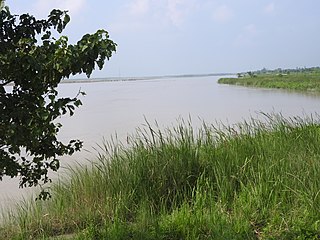
The Koshi Tappu Wildlife Reserve is a protected area in the Terai of eastern Nepal covering 176 km2 (68 sq mi) of wetlands in the Sunsari, Saptari and Udayapur Districts. It comprises extensive reed beds and freshwater marshes in the floodplain of the Kosi River, and ranges in elevation from 75 to 81 m. It was established in 1976 and designated as a Ramsar site in December 1987. It hosts Nepal's last remaining herd of the wild water buffalo.
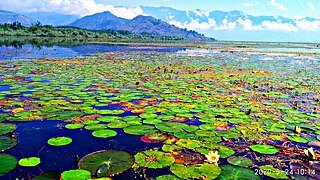
Wular Lake, also known as Wolar in Kashmiri, is one of the largest fresh water lakes in South Asia. It is located near Bandipora town in the Bandipora district of Jammu and Kashmir, India. The lake basin was formed as a result of tectonic activity and is fed by the Jhelum River and stream Madhumati and Arin.
Chashma and Taunsa Barrage Dolphin Sanctuary is located in Mianwali District, Punjab, Pakistan. It was declared open to the public in 1972. Since the 1970s, the population of the Indus river dolphins has significantly increased there. It is a very important breeding and wintering area for wide variety of waterfowl regularly 20000 birds it is the largest preservation area for endangered indus dolphins.

The Hokersar is a wetland conservation area in Zainakote, near Srinagar city in Srinagar district of Jammu and Kashmir, India. It lies in the Kashmir Valley, 10 kilometres (6.2 mi) northwest of Srinagar. The Hokersar, which spreads over 1,375 hectares (13.75 km2), is a designated bird sanctuary.

Tso Moriri or Lake Moriri or "Mountain Lake", is a lake in the Changthang Plateau of Ladakh in India. The lake and surrounding area are protected as the Tso Moriri Wetland Conservation Reserve.

Maharana Pratap Sagar, also known as Pong Reservoir or Pong Dam Lake is a large reservoir in Fatehpur, Jawali and Dehra tehsil of Kangra district of the state of Himachal Pradesh in India. It was created in 1975, by building the highest earthfill dam in India on the Beas River in the wetland zone of the Siwalik Hills. Named in the honour of Maharana Pratap (1540–1597), the reservoir or the lake is a well-known wildlife sanctuary and one of the 49 international wetland sites declared in India by the Ramsar Convention. The reservoir covers an area of 24,529 hectares, and the wetlands portion is 15,662 hectares.

Dipor Bil, also spelled Deepor Beel , is located to the south-west of Guwahati city, in Kamrup Metropolitan district of Assam, India. It is a permanent freshwater lake, in a former channel of the Brahmaputra River, to the south of the main river. In 1989, 4.1 km² of the area was declared a wildlife sanctuary by the Government of Assam. It is listed as a wetland under the Ramsar Convention which designated the lake as a Ramsar Site in November 2002 for undertaking conservation measures on the basis of its biological and environmental importance.

The wildlife of Pakistan comprises a diverse flora and fauna in a wide range of habitats from sea level to high elevation areas in the mountains, including 195 mammal, 668 bird species and more than 5000 species of Invertebrates. This diverse composition of the country's fauna is associated with its location in the transitional zone between two major zoogeographical regions, the Palearctic, and the Oriental. The northern regions of Pakistan, which include Khyber Pakhtunkhwa and Gilgit Baltistan include portions of two biodiversity hotspot, Mountains of Central Asia and Himalayas.
Kanjli Wetland is a man-made Wetland that subsumes the Kanjli Lake, and is located in the Kapurthala district of Punjab state in India. It was created in 1870 by constructing the headworks across the perennial Bien River, a tributary of the Beas River to provide irrigation facilities to the hinterland. The rich biodiversity of the wetland comprising aquatic, mesophytic and terrestrial flora and fauna including some important species of plants and animals was recognized internationally by the Ramsar Convention in 2002 by designating the Kanjli Lake in the List of Wetlands of International Importance. In this context, it is reported that the Punjab State which has 14 wetlands covering an area of 225.76 km2 has the unique position of three of its wetlands viz., the Kanjli Wetland covering an area of 490 ha of which the Kanjli Lake water spread is 184 ha), the Harike Wetland and the Ropar Wetland chosen by the Ministry of Environment and Forest (MoE&F), Government of India for their conservation and management are now also included in the Ramsar list covering a total area of 5650 ha; Kanjli is upstream of Harike wetland located in the Beas river basin while the Ropar wetland is in the Roopnagar district.

Ropar Wetland, also named Ropar Lake, is a man-made freshwater riverine and lacustrine wetland. The area has at least 9 mammal, 154 bird, 35 fish, 9 arthropod, 11 rotifer, 9 crustacean and 10 protozoan species, making it biologically diverse. This important ecological zone is located in the Shivalik foothills of the Lower Himalayas and was created in 1952 on the Sutlej River, in the Punjab state of India, by building a head regulator to store and divert water for beneficial uses of irrigation, drinking and industrial water supply. The endangered turtle Chitra indica and the threatened snake Python molurus, as per IUCN Red List, are reported to be resident in the wetland. Considering the wetland's diverse and rich biodiversity, Ramsar Convention has included Ropar Wetland as one of the Ramsar sites among the 42 sites listed under India, for "the conservation of global biological diversity and for sustaining human life through the ecological and hydrological functions they perform."

The Central Asian Flyway (CAF), Central Asian-Indian Flyway, or Central Asian-South Asian Flyway is a flyway covering a large continental area of Eurasia between the Arctic Ocean and the Indian Ocean and the associated island chains. The CAF comprises several important migration routes of waterbirds, most of which extend from the northernmost breeding grounds in Siberia to the southernmost non-breeding wintering grounds in West Asia, India, the Maldives and the British Indian Ocean Territory.

Odisha, a state in eastern India, is extremely diverse and gives the state abundance of natural beauty and wildlife. The districts in the interior are thickly covered by tropical moist deciduous and tropical dry deciduous forests. The hills, plateaus and isolated areas of the northeastern part of the state are covered by the tropical moist deciduous forests whereas the dry deciduous forests are located in the southwest region of the state. Some of the trees which grow in abundance in Odisha are bamboo, teak, rosewood, sal, piasal, sanghvan and haldi. There are 479 species of birds, 86 species of mammals, 19 species of amphibians and 110 species of reptiles present in Odisha. The state is also an important habitat for the endangered olive ridley turtles and Irrawaddy dolphins. Koraput district of southern Odisha has been identified by Food and Agriculture Organisation (FAO) of UN as Global Agricultural Heritage site which is among only other three sites in the world. Other sites are in Peru, China and Philippines.
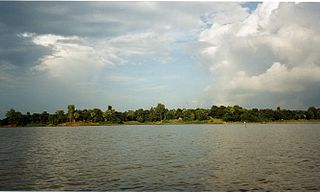
Rudrasagar Lake, also known as Twijilikma, is a lake located in Melaghar, Tripura, India.
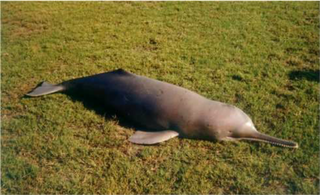
The Indus river dolphin is a species of toothed whale in the family Platanistidae. It is endemic to the Indus River basin in Pakistan and Beas River in northwestern India. This dolphin was the first discovered side-swimming cetacean. It is patchily distributed in five small, sub-populations that are separated by irrigation barrages.

Kali Bein is a rivulet in Punjab, India that flows into the confluence of the rivers Beas and Satluj at Harike. Guru Nanak attained enlightenment after taking a bath in the Kali Bein, and despite its religious history in Sikhism, the rivulet is not considered holy by the Sikhs in Punjab, as no bodies of water are considered holy in Sikhism aside from the Sikh Sarovars(pools of water within gurdwaras) of Gurdwaras. In the wake of the Green Revolution, the Kali Bein became progressively polluted until it was cleaned and rejuvenated in a mass action led by Sant Balbir Singh Seechewal in the 2000s.
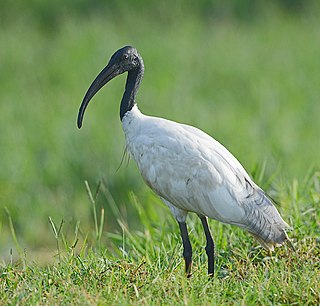
Basai wetland, located in Basai village in Gurgaon tehsil in Gurgaon district in Haryana, India, is a flora and fauna rich water body. It is recognised as one of India's Important Bird and Biodiversity Areas and is of global conservation significance as it supports populations of several endangered, vulnerable, and threatened bird species. Basai wetlandis recognised globally as an Important Bird Area (IBA) by the BirdLife International housing 20,000 birds of over 280 species including migratory birds and endangered birds, has not yet been declared a protected wetland by the Government of Haryana.
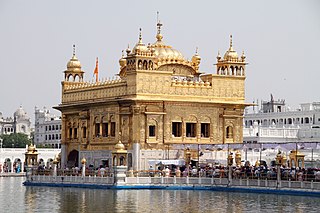
The state of Punjab is renowned for its cuisine, culture and history. Punjab has a vast public transportation and communication network.
The Beas Conservation Reserve covers an 185 km stretch of the river Beas. The area of the Reserve lies primarily in north-west Punjab. It was declared a conservation reserve by the government of Punjab, India in 2017. The Beas flows down meandering from the Himalayan foothills to Harike Headworks, where it spreads into multiple channels. The braided channels form islands and sand bars creating a complex environment that supports rich biodiversity. In September 2019, the reserve was declared a Ramsar site under the aegis of the 1971 Ramsar Convention on Wetlands of International Importance.































